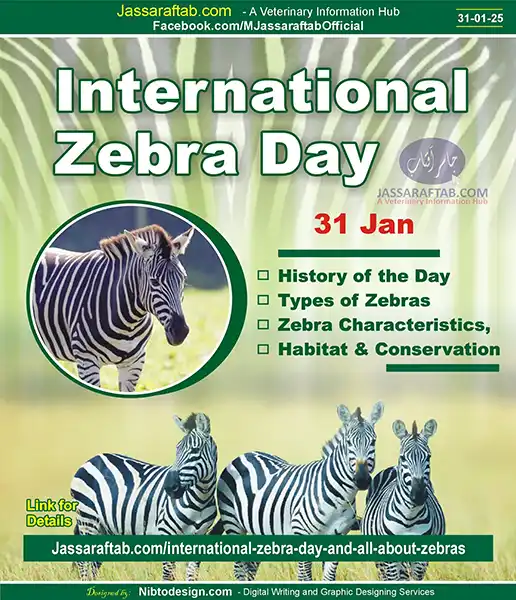
International Zebra Day History | Types of Zebra | Zebra Characteristics, Habitat & Conservation
International Zebra Day is celebrated annually on 31st January. This day is celebrated to raise awareness about Zebra Conservation and to protect Zebra Habitat. They are native to Africa. There are three types of zebra i.e. Grevy’s zebra, Plains zebra, and Mountain zebra. Moreover, zebras, with their striking black-and-white patterns, are symbols of Africa’s wilderness. Why do zebras have stripes and What are Zebra Harems? This article will highlight Zebra Harems along with Zebra Characteristics.
This article provides information about Zebra Characteristics, Zebra Habitat, Zebra Conservation, Zebra Harems, and Types of Zebra.
History of International Zebra Day
The origin of the International Zebra Day is unclear. However, it is believed that this day was initiated by conservation organizations including the Smithsonian’s National Zoo & Conservation Biology Institute and the International Union for Conservation of Nature (IUCN). This day was established in response to alarming declines in zebra populations due to habitat loss, poaching, and human encroachment. However, this day was created to spotlight the urgent need for zebra protection.
Purpose of International Zebra Day
Zebras are ecological engineers. Their grazing habits help maintain grassland health, which benefits other species. This day aims to educate the people about zebra species and their roles in ecosystems. It also highlights the threats like habitat loss, poaching, and climate change. Moreover, this day urges individuals, groups, and governments to find proactive ways to save the zebras and their natural habitats.
Types of Zebra
- Grevy’s Zebra
The Grevy’s zebra is the largest and most threatened zebra species. It has narrow, closely spaced stripes and large, rounded ears. They are adapted to its arid savanna habitat. Unlike other zebras, it is more solitary or forms loose herds. Only 3,000 Grevy’s Zebra are left in Kenya and Ethiopia.
World Okapi Day and History | Characteristics and Okapi Conservation Status
- Mountain Zebra
They are recognized by a distinctive dewlap (neck flap) and gridiron stripe pattern on their rump. Moreover, they inhabit rocky slopes and grasslands. Around 35,000 mountain zebras are found in Namibia and South Africa.
- Plains Zebra
This is the most widespread species, with roughly 500,000 across eastern and southern Africa. The plains zebra is known for bold, broad stripes and social herds that migrate seasonally.
Zebra Characteristics
Zebras are African mammals. They belong to the genus Equus and the family Equidae. They are closely related to domestic horses. Moreover, they have bold black-and-white striping patterns which is the most distinguished among zebra characteristics. They have a white coat with white and Black stripes.
Their size ranges from 3.5 to 5 feet (1.1 to 1.5 meters) at the shoulder and weight from 400 to 900 pounds depending upon the species. They are single-hoofed ungulates built for speed and migration. They have strong hooves and can run up to 65 km/h to escape predators. Moreover, they have excellent eyesight, even at night, and large, movable ears that help detect danger.
Giraffe Characteristics and International Day
Zebras have strong social bonds and live in groups called zebra harems. These zebra harems consist of a dominant stallion, several mares, and their young. They live in herds, which protect predators like lions and hyenas.
Primarily, they are herbivores and graze on grass but also eat leaves and bark. They require a constant water supply and travel long distances to find it. Moreover, they have adaptability which allows them to survive in diverse environments. Each species of Zebra has different social behavior. In addition, they form a defense circle around weak members to protect them from predators. Their powerful kick can injure or kill predators.
Why do zebras have stripes?
Each zebra has a unique stripe pattern, much like a human fingerprint. Stripes may confuse predators like lions during a chase, making it hard to target individual zebras. This pattern can also regulate body temperature. The Fly Protection Hypothesis suggests zebra’s black-and-white stripes help deter blood-sucking flies, particularly horse flies and tsetse flies. These insects spread deadly diseases among equines like African horse sickness and Equine Influenza. Black stripes absorb heat, while white stripes reflect it, helping zebras stay cool under the African sun.
Zebra Habitat and International Zebra Day
Zebras are native to Africa. They inhabit a range of ecosystems, including grasslands, savannas, woodlands, and semi-arid regions. Their habitats can vary significantly depending on the species. Plains Zebra species are found in open, grassy plains with scattered trees. They range across Eastern and Southern Africa including countries like Kenya, Tanzania, Botswana, Zimbabwe, and South Africa. Moreover, Grevy’s Zebra are found in semi-arid grasslands and dry scrublands, sparsely vegetated regions. They range from northern Kenya to parts of Ethiopia. On the other hand, Mountain zebra prefers rocky, mountainous terrains at high elevations in South Africa and Namibia. Zebra Day highlights the threats faced by zebra habitats.
Zebra Conservation and International Zebra Day
Zebras are facing habitat loss due to human encroachment, agricultural practices, and livestock grazing. Every species is facing threats and their population is declining. The Zebra conservation status varies by species of types of zebra. The International Union for Conservation of Nature (IUCN) classifies Grevy’s zebras as endangered, with fewer than 2,500 individuals left in the wild. Mountain zebras are listed as vulnerable. Plains zebras are near threatened. Many conservation organizations are working to save the Zebras and zebra habitat.
The African Wildlife Foundation (AWF) implements zebra conservation strategies, including anti-poaching initiatives and protected area management to protect them. Grevy’s Zebra Trust specifically targets the conservation of Grevy’s zebras by working closely with local communities to promote coexistence and sustainable land use. WWF (World Wildlife Fund) also plays a significant role in advocating for zebra and protection through policy development and zebra habitat conservation programs. These organizations collaborate with governments, researchers, and local populations to ensure a sustainable future for zebras. It is necessary to protect and expand zebra habitats to save them from extinction.







90 Comments
https://evertrustmeds.shop/# Ever Trust Meds
Buy Tadalafil 20mg: EverTrustMeds – Ever Trust Meds
https://evertrustmeds.shop/# EverTrustMeds
Canadian pharmacy prices: escrow pharmacy canada – canadian pharmacy
Online Mexican pharmacy: Online Mexican pharmacy – BajaMedsDirect
Best Indian pharmacy: Best Indian pharmacy – Best online Indian pharmacy
http://bajamedsdirect.com/# mexican pharmacy
mexico pharmacy: Best Mexican pharmacy online – Mexican pharmacy price list
canadian pharmacy: Canadian pharmacy prices – Canadian pharmacy prices
https://bajamedsdirect.shop/# mexico pharmacy price list
https://curamedsindia.com/# best online pharmacy no prescription
Buy sildenafil [url=https://truevitalmeds.shop/#]Sildenafil 100mg price[/url] Buy sildenafil
buy sildenafil from canada: Sildenafil 100mg price – sildenafil prescription australia
Buy Tadalafil online [url=https://tadalmedspharmacy.shop/#]Generic tadalafil 20mg price[/url] Buy Tadalafil 20mg
Mexican pharmacy price list: Online Mexican pharmacy – Best online Mexican pharmacy
Sildenafil 100mg price [url=https://truevitalmeds.com/#]sildenafil[/url] Sildenafil 100mg price
Buy Tadalafil online: Generic tadalafil 20mg price – Buy Tadalafil online
Buy sildenafil online usa [url=http://truevitalmeds.com/#]Buy sildenafil online usa[/url] Sildenafil 100mg price
sildenafil over the counter us: Sildenafil 100mg price – Sildenafil 100mg
Sildenafil 100mg [url=https://truevitalmeds.shop/#]Sildenafil 100mg[/url] Sildenafil 100mg price
Online Mexican pharmacy: MedicExpress MX – Online Mexican pharmacy
MedicExpress MX [url=https://medicexpressmx.shop/#]mexican pharmacy[/url] Online Mexican pharmacy
mexican pharmacy: Online Mexican pharmacy – MedicExpress MX
sildenafil [url=https://truevitalmeds.com/#]Buy sildenafil online usa[/url] true vital meds
Legit online Mexican pharmacy: Best online Mexican pharmacy – MedicExpress MX
true vital meds [url=http://truevitalmeds.com/#]Sildenafil 100mg[/url] how much is sildenafil 50 mg
Buy Amoxicillin for tooth infection: Purchase amoxicillin online – Amoxicillin 500mg buy online
buy zithromax online [url=https://zithromedsonline.shop/#]buy zithromax online[/url] buy zithromax
AmoxDirect USA: buy amoxil – buy amoxicillin
buy finasteride [url=https://regrowrxonline.com/#]Propecia buy online[/url] Propecia buy online
generic zithromax: cheap zithromax – buy zithromax online
You can keep yourself and your stock nearby being wary when buying panacea online. Some pharmacy websites function legally and provide convenience, solitariness, rate savings and safeguards as a replacement for purchasing medicines. buy in TerbinaPharmacy https://terbinafines.com/product/zantac.html zantac
More posts like this would create the online elbow-room more useful. TerbinaPharmacy
low-cost ivermectin for Americans: order Stromectol discreet shipping USA – generic ivermectin online pharmacy
Prednisone without prescription USA: Prednisone tablets online USA – Prednisone tablets online USA
https://predniwellonline.com/# online pharmacy Prednisone fast delivery
PredniWell Online: order prednisone 10 mg tablet – PredniWell Online
order gabapentin discreetly: generic gabapentin pharmacy USA – generic gabapentin pharmacy USA
https://predniwellonline.shop/# how to get Prednisone legally online
British online pharmacy Viagra: Viagra online UK – viagra uk
https://britpharmonline.com/# BritPharm Online
Viagra online UK: buy sildenafil tablets UK – buy viagra
This is the kind of literature I positively appreciate.
https://britmedsdirect.com/# Brit Meds Direct
BritMeds Direct: online pharmacy – order medication online legally in the UK
http://britmedsdirect.com/# online pharmacy
order ED pills online UK: viagra – viagra
http://amoxicareonline.com/# cheap amoxicillin
best UK online chemist for Prednisolone: UK chemist Prednisolone delivery – UK chemist Prednisolone delivery
https://britmedsdirect.com/# order medication online legally in the UK
http://britmedsdirect.com/# BritMeds Direct
private online pharmacy UK: pharmacy online UK – UK online pharmacy without prescription
order ED pills online UK: buy sildenafil tablets UK – buy viagra online
MedRelief UK: order steroid medication safely online – Prednisolone tablets UK online
http://britmedsdirect.com/# online pharmacy
buy prednisolone: cheap prednisolone in UK – UK chemist Prednisolone delivery
https://britmedsdirect.com/# BritMeds Direct
UK chemist Prednisolone delivery: order steroid medication safely online – MedRelief UK
https://britmedsdirect.com/# Brit Meds Direct
http://medreliefuk.com/# Prednisolone tablets UK online
buy amoxil: buy Doxycycline – trusted online pharmacy USA
buy cialis online [url=https://tadalifepharmacy.com/#]safe online pharmacy for Cialis[/url] discreet ED pills delivery in the US
mexico pharmacy [url=http://medicosur.com/#]MedicoSur[/url] mexican pharmacy
safe online medication store [url=https://zencaremeds.com/#]buy clomid[/url] safe online medication store
buy Doxycycline: online pharmacy indonesia – order medicine discreetly USA
TadaLife Pharmacy [url=https://tadalifepharmacy.com/#]generic Cialis online pharmacy[/url] tadalafil tablets without prescription
Cialis online USA: discreet ED pills delivery in the US – affordable Cialis with fast delivery
Cialis générique pas cher: cialis sans ordonnance – cialis sans ordonnance
farmacia online barcelona: tadalafilo – comprar Cialis online España
Tadalafil 20mg Bestellung online: Cialis Preisvergleich Deutschland – cialis kaufen
cialis generico: tadalafilo 5 mg precio – cialis precio
tadalafilo sin receta: cialis precio – cialis precio
IntimiSanté: achat discret de Cialis 20mg – achat discret de Cialis 20mg
Intimi Santé: tadalafil sans ordonnance – livraison rapide et confidentielle
cialis 20mg preis: potenzmittel cialis – Cialis generika günstig kaufen
comprar cialis: Tadalafilo Express – farmacia online fiable en España
billig Viagra Sverige: köp receptfria potensmedel online – köp receptfria potensmedel online
http://confiafarmacia.com/# farmacia online para hombres
MannensApotek [url=http://mannensapotek.com/#]köp receptfria potensmedel online[/url] mannens apotek
Sildenafil-tabletter pris: köpa Viagra online Sverige – apotek online utan recept
http://herengezondheid.com/# betrouwbare online apotheek
Viagra generico con pagamento sicuro: pillole per disfunzione erettile – ordinare Viagra generico in modo sicuro
erektionspiller på nätet: diskret leverans i Sverige – diskret leverans i Sverige
https://mediuomo.com/# trattamento ED online Italia
https://herengezondheid.shop/# erectiepillen discreet bestellen
专业构建与管理谷歌站群网络,助力品牌实现全域流量的强势增长。谷歌站群
Khám phá thế giới giải trí trực tuyến đỉnh cao tại MM88, nơi mang đến những trải nghiệm cá cược thể thao và casino sống động.
Đến với J88, bạn sẽ được trải nghiệm dịch vụ cá cược chuyên nghiệp cùng hàng ngàn sự kiện khuyến mãi độc quyền.
Với giao diện mượt mà và ưu đãi hấp dẫn, MM88 là lựa chọn lý tưởng cho các tín đồ giải trí trực tuyến.
iwin – nền tảng game bài đổi thưởng uy tín, nơi bạn có thể thử vận may và tận hưởng nhiều tựa game hấp